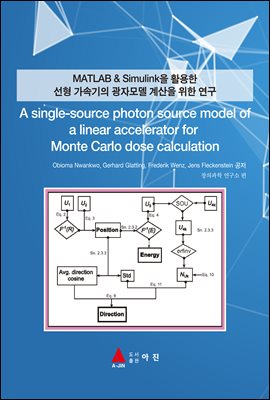
MATLAB & Simulink을 활용한 선형 가속기의 광자모델 계산을 위한 연구(A single-source photon source model of a linear accele
- 저자Obioma Nwankwo, Gerhard Glatting, Frederik Wenz, Jens Fleckenstein 저
- 출판사아진
- 출판일2020-07-14
- 등록일2020-12-21
- SNS공유


- 파일포맷PDF
- 파일크기8MB
- 공급사YES24
-
지원기기
PC
PHONE
TABLET
프로그램 수동설치
전자책 프로그램 수동설치 안내
아이폰, 아이패드, 안드로이드폰, 태블릿,
보유 1, 대출 0,
예약 0, 누적대출 8, 누적예약 0
책소개
A PSF of a 6 MV photon beam was generated by simulating the interactions ofprimary electrons with the relevant geometries of a Synergy linear accelerator
(Elekta AB, Stockholm, Sweden) and recording the particles that reach a plane 16
cm downstream the electron source. Probability distribution functions (PDFs) for
particle positions and energies were derived from the analysis of the PSF. These
PDFs were implemented in the VSM using inverse transform sampling. To model
particle directions, the phase space plane was divided into a regular square grid.
Each element of the grid corresponds to an area of 1 mm2 in the phase space
plane. The average direction cosines, Pearson correlation coefficient (PCC) between
photon energies and their direction cosines, as well as the PCC between the
direction cosines were calculated for each grid element. Weighted polynomial
surfaces were then fitted to these 2D data. The weights are used to correct for
heteroscedasticity across the phase space bins. The directions of the particles
created by the VSM were calculated from these fitted functions. The VSM was
validated against the PSF by comparing the doses calculated by the two methods
for different square field sizes. The comparisons were performed with profile and
gamma analyses.
목차
제 1편 : SIMULINK 기본편1.1 SIMULINK의 시작 1
블록의 연결 5
블록 파라미터의 설정 7
시뮬레이션 파라미터 (Configuration Parameters)의 설정 8
시뮬레이션의 수행 9
블록 파라미터의 표시 9
복수 데이터의 표시 11
2.2 동적 시뮬레이션 13
이차 미분방정식 17
선형 상태변수 모델 23
DC 모터의 시뮬레이션 24
함수 블록의 사용 29
차분방정식(difference equation)의 모델링 34
Subsystem(부시스템)의 구성 37
제 2편 : 연구논문
A single-source photon source model of a linear accelerator for Monte
Carlo dose calculation
1. Introduction 42
2. Materials and methods 43
3. Results 48
4. Discussion 53
5. Conclusion 54
6. References 55

















